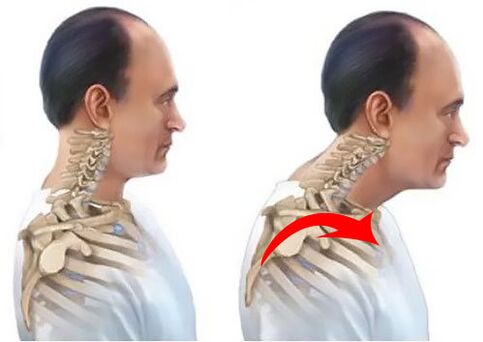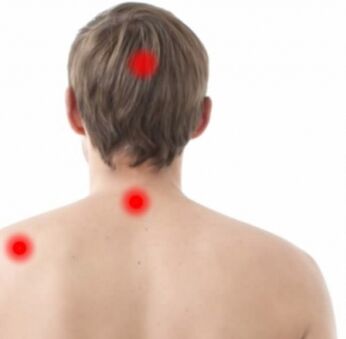Unfortunately, today, due to cervical osteochondrosis, the symptoms of headache and pain in the neck are almost all adults.And in 70% of the population over 25 years (possibly earlier), such symptoms occur periodically.Doctors diagnose: Cervical osteochondrosis and prescribe treatment, depending on the scene and nature of the disease.

What is cervical osteochondrosis?
These are degenerative changes in the spinal column intervertebral discs, arising due to the uneven load of the spine.The bodies of the spine, from the first or seventh cervical region, are gradually deformed, exhausted and destroyed.The main and major symptom of cervical osteochondrosis is headache, and pain sensations can be affected by the neck, chest, as well as on the shoulder and other parts of the spine.The cervical spine is connected to all its departments: breast, lumbar, sacred and Kopchikov.All vertebrates are consistently interconnected vertically.And any disruption of the spine of the cervical region affects the work of the entire spine.
Why can headaches be considered a major symptom of cervical osteochondrosis?
The cervical region is the most mobile and most vulnerable in all parts of the spine.It contains very small vertebrates, much thinner than the vertebrates of other sections.In addition, all time on the neck should support the head direct.Neck muscle tension causes constant cramping of the head and neck vessels.Therefore, the headache that occurs from time to time is either consumed for hours and days.A large number of muscles are connected to the back of the neck.Eight short deep muscles provide the back of the bone with the first and second cervical spine.The two deep muscles are connected to the back of the seven cervical spine.The long muscles of the neck and head are connected to each other on the back of the head and each spine.Any muscle tension and spasm can cause headaches and pain in the neck.Therefore, you should fight headaches, starting with cervical osteochondrosis.
Other causes of cervical osteochondrosis
The causes of cervical osteochondrosis may be called the following factors:
- Hereditary
- A tempting lifestyle
- Overweight
- Heavy loads on the spine
- Stress and nervous shocks
- Metabolic disorders
- Wearing inappropriate shoes
- Infutable meal
- A period of pregnancy
As you can see, there is no specific cause that causes cervical osteochondrosis.The process of degenerative changes in the intervertebral discs usually occurs slowly and imperial.
Stages of development of cervical osteochondrosis
Very often, a person does not suspect a disease such as cervical osteochondrosis of the sensation and headache, and pain in the neck prefer not to pay attention, or is limited to drug coloring.However, osteochondrosis develops in several stages:
- In the first stage, the discomfort in the neck begins with prolonged walking, long sitting on a computer or in one condition.In intervertebral discs, small seals begin to form.Degenerative changes in the vertebrates at an early stage.
- In the second stage of the development of osteochondrosis, prolonged pain is found in the shore, in the temporal part of the head, on the neck.There may be a bell on the ears, pain when tilted and heading.Neck spine mobility begins to decline, with the protrusion of intervertebral discs.
- In the third stage, periods of headaches are expressed.People feel dizzy, lack of air, shortness of breath.Pain in the shoulders and various parts of the spinal column can exist.Neck mobility is limited.The fiber link of intervertebral discs is destroyed, the nucleus of the Eastern loses its elasticity.Degenerative changes in vertebrate discs are calculated.
- The last stage of the development of cervical osteochondrosis is characterized by the presence of intervertebral hernia.Most devastating changes are irreversible.Almost all parts of the spine are affected.Treatment is only possible through surgical intervention.
Symptoms of cervical osteochondrosis
With headaches and neck pain, depending on the stage of the development of the cervical osteochondrosis, many symptoms that accompany this disease can be called:
- Feeling gravity in the head
- By pressing the spine
- The sensation of the neck of the neck
- Noise in the ears and the feeling of swelling
- Dizziness
- Bumps on the shoulders or shoulder blades
- Chest pain
- A feeling of lack of air
- Fed the same
- Nausea
- Hanging in the eyes, flying in front of my eyes
- Improving body temperature
- Increase in blood pressure
Symptoms can suddenly occur or have a regular nature.Often the pain in the neck and the stomach of the head feels in the evening.The motionless sitting in one position is influenced.The arteries of the spine, which carry blood in the brain, contract and spasm.As a result of the manifestation of blood circulation, the brain is primarily affected.Often the arteries and smoking spasms in the neck cause limited mobility.A person cannot turn his neck temporarily, or most often for a long period.Dizziness, noise and bells in the ears, swelling also occurs as a result of reducing blood flow from the spine arteries.Dizziness can be systemic rather than systemic.With systemic dizziness, a person has a circular rotation of objects around.No -systemic dizziness, there is no sensation of circular rotation, but there is an uncertain condition when the body is standing, and nausea may also be noted.

Often, with cervical osteochondrosis, nerve pinches occur.This condition is caused by the movement of the spine in any direction in the spinal column.Destroyed vertebrates weaken nerve endings, this causes spasms of blood vessels, lack of air.With prolonged lack of oxygen, a person can start breathing failure.Heartburn, weakening of pain in the heart area, increased blood pressure - frequent concomitant symptoms of cervical spine intervertebral discs.
The consequences and complications of cervical osteochondrosis
In the case of normal blood flow to the spine arteries, the autonomic nervous system suffers.Spasms of blood vessels and blood pressure can lead to an unpleasant condition.In case of bleaching, you should immediately provide first aid to the person.The body is necessary so that the legs are above the head, this will cause normal blood circulation to the neck and activate the stream in the brain.Sometimes, in order to develop the cervical spine and frozen neck with a long -term body in one condition, the person begins to tightly and quickly turn left and right.As a result, the spine artery is spasmodic, and instead of being released, a person begins to dizziness, ears in the ears, sharp headache, which can also cause an increase in blood pressure and a straining condition.
The main and common complication of cervical osteochondrosis is intervertebral hernia and prosthesis.The spine hernia is the result of degradation and destruction of the intervertebral disc.With hernia and protrusions, weakening of the contents of the fiber ring and looting in any direction.At the same time, a person feels constant pain due to friction of red intervertebral discs.The most severe complication of cervical osteochondrosis is the disease - myelopathy in which the spinal cord is destroyed.Myelopathy is most often localized in the cervical spine.In this disease, a person feels bumps or limbs, weakness and involuntary deviation from the body's muscles, chest pain and shoulder blades.
Diagnosis and detection of cervical osteochondrosis
In the presence of one or more symptoms indicating the presence of cervical osteochondrosis, you should consult your doctor.A neuropathologist or an orthopedist examines a patient who has an evaluation of cervical spine pain and mobility,It will reveal the accompanying symptoms and we recommend that diagnostic measures are necessary.The most reliable in our time is magnetic -resonance imaging (MRI).As a result of the patient's examination, the presence of cervical osteochondrosis, as well as protrusion or hernia, can be manifested by 100% accuracy.As a contraindication for magnetic resonance diagnosis, the patient may be attributed to the presence of a cardiostimulator.Children's age and pregnancy are not used for contraindications because there is no X -Ray irradiation during MRI.Unlike the X-ray image, where only skeletal bones are seen, with magnetic resonance imaging, all soft tissue, muscles, ligaments, discs, spinal cord can be seen in the neck and nerve fibers.X -Ray, as a method of detecting cervical osteochondrosis, is used only in the early stages of the disease.The advantage of this method of examination can be considered at speed, availability and low price.Using x -ray, only the quality of intervertebral disc changes can be detected, with the exception of the examination of soft tissues, muse and nerve fibers in the neck.
Prevention of cervical osteochondrosis
As a cervical osteochondrosis prevention, some tips can be listed:
- Avoid gravity.If necessary, elevate heavy, you should properly distribute the load on the whole spine.
- Avoid prolonged areas in one condition, exclude many hours of television programs without changing their body position.
- The bed and pillow should be convenient for sleep and rest.Orthopedic mattress and anatomical orthopedic pillow, with the individual size selected.
- It is necessary to observe the rules that prevent the posture curve.In the straight and equal position of the head, neck and spinal cord when walking and sitting not only the cervical spine, but also the health of the entire spine.
- Proper nutrition with large amounts of protein products, grains, fruits and vegetables provides the body with the necessary vitamins and trace elements.
- Including a food diet such as jelly, seafood and seafood with collagen will undoubtedly be useful for skeletal, ligament and cartilage bones.
- Proper and sufficient use of simple clean water will prevent the content of intervertebral discs and the formation of cervical osteochondrosis.
- Physical exercise and physical activity at any age are very important.In addition to walking in the fresh air, very cowardly, swimming, aquerobics, yoga and pilates are very useful.
Treatment.Cervical osteochondrosis of the cervical
Cervical osteochondrosis is used for medications, physio - procedures, massage, special exercises and gymnastics, and in extreme cases, surgical intervention is not excluded.Analgesics are used successfully to relieve pain.To mitigate the inflammatory process, unwanted medications are indicated.With muscle cramps, doctors recommend soothing.Regular spasms of the neck muscles require a special orthopedic collar.Anti -anamanthic ointments are used to reduce pain.Sluggish cervical osteochondrosis, physio - procedures are prescribed outside exacerbations.They have been well proven in the treatment of Oster Osteochondrosis: magnetotherapy, electrophoresis, UHF and shock wave therapy.Physio - During procedures, inflammatory processes in the body decrease, the cervical spine improves blood.Normal massage is also indicated for osteochondrosis.
For the treatment of cervical osteochondrosis between exercises, 5 home is widely used at a slow pace.Repeat exercises three to five times.
- First exercise.It consists of left and right with slow turns.The shoulders remain motionless.
- The exercise is the second.It is necessary to press your palm with your palm, slightly strain the neck muscles.
- Exercise is the third.It consists of left and right in the head, and to the left, you have to lower yourself as low as possible and touch the left shoulder of the left ear, and to the right - touch your right ear to the right shoulder.
- Exercise Fourth.It is advisable to the left side of the left palm on the left side, like the right palm, against the temple, on its right side.
- Exercise Fifth.Slowly the tilted chin on the neck, and turn your head back, then turn right.
These simple but effective exercises can be done every day, 10-15 minutes of free time in the warehouse.
Conclusion
Our body has five departments of the spine.The cervical spine deserves special attention.Depending on the complex symptoms, the presence of many related diseases and the absence of sufficient control, the presence of cervical osteochondrosis is a serious problem.Starting with the usual light discomfort on the neck, without proper treatment, the intervertebral discs begin to degenerate, which causes a lot of inconvenience.Dizziness, pain in the back and temporal parts, neck pain, ear bells and noise - the main but not the only symptoms of cervical osteochondrosis manifestations.In order for cervical osteochondrosis to move to irreversible changes and consequences in its case, you must follow simple nutrition rules and water regimens, regularly engage in physical exercise, control the posture and position of the head, standing or sitting.The prolonged discovery of the body is strictly contraindicated.
































